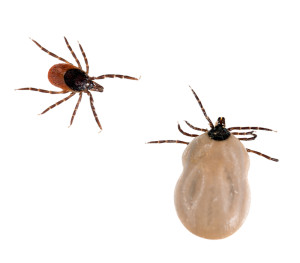Lyme Disease: Prevention Is Key
There is no currently available vaccine against Lyme disease, so prevention is your best defense.
With more than 300,000 Americans infected with Lyme disease each year, you may be wondering whether there’s a vaccine against the condition. The answer is no. And because Lyme disease symptoms often resemble flu symptoms (see “Lyme Disease Basics” sidebar), it’s common for the condition to go undiagnosed. That can be a real problem for many people, because Lyme disease complications can be serious.
Why Isn’t There a Lyme Disease Vaccine?
Stanley Plotkin, emiritus professor of pediatrics at the University of Pennsylvania’s Perelman School of Medicine, invented rubella (German measles) vaccine and co-invented the rabies vaccine. Professor Plotkin’s son developed a serious complication from Lyme disease. “The worst recent failure to use an effective vaccine, in my view, has been the lack of prophylaxis against Lyme disease,” Professor Plotkin said in a recent editorial for the New England Journal of Medicine.
In fact, there was a vaccine against Lyme disease symptoms at one time. Approved by the Food and Drug Administration in 1998, the vaccine reduced the risk for Lyme disease by 76 percent. Unfortunately, there was no real demand for it, because the incidence of Lyme disease wasn’t as high then as it is now.
The good thing is that at several new vaccines are currently being researched, in the wake of figures from the Centers for Disease Control and Prevention showing an increase in ticks carrying the disease.
How To Prevent Lyme Disease: Tips on Avoiding Ticks
To prevent tick bites, follow these tips:
- If you’re out walking or hiking, avoid wooded and brushy areas with high grass and leaf litter, and walk in the center of trails.
- Use insect repellents that contain 20 to 30 percent DEET (chemical name: N,N-diethyl-meta-toluamide) on exposed skin and clothing, for tick protection that lasts up to several hours. Interested in DEET-free repellents that are effective on ticks? Find the right tick repellent for you.
- Use products that contain permethrin to treat clothing and gear, such as boots, pants, socks, and tents, after being in a tick-infested area.
- Bathe or shower as soon as possible after coming indoors (preferably within two hours) to wash off and more easily find ticks that are crawling on you.
- Conduct a full-body tick check using a handheld or full-length mirror to view all parts of your body upon return from tick-infested areas.
- Examine clothing, gear, and pets for ticks.
- After coming in from walking or hiking through a wooded area, place clothing in a dryer on high heat for an hour to kill any ticks that might be lurking.
Protect Yourself from Lyme Disease Symptoms
If you do discover a tick on your body, don’t panic—you’re unlikely to develop Lyme if the tick is attached for less than 36 hours. As to the issue of how long the tick as been attached, go by its size. A tick that hasn’t fed is tiny: not much larger than a pinhead. If it’s larger, then it may have fed. Consider this a health red flag and consult your doctor, especially if you live in an area where the black-legged tick is endemic.
You can remove a tick by pinching it as close as possible to the surface of your skin (ideally, you should use fine-tipped tweezers), and pulling upward with steady, even pressure. Avoid twisting the tick, as its mouthparts could detach and remain embedded in your skin.
FYI
LYME DISEASE BASICS
Lyme disease, according to the Centers for Disease Control, is caused by the bacterium Borrelia burgdorferi and transfers to humans through the bite of an infected black-legged tick. Blacklegged ticks (or deer ticks—Ixodes scapularis) spread the disease in the northeastern, mid-Atlantic, and north-central U.S. The western black-legged tick (Ixodes pacificus) spreads Lyme disease on the Pacific Coast.
Ticks can bite and attach any part of the human body but often turn up in hard-to-see areas such as the groin, armpits, and scalp. A tick must be attached for at least 36 to 48 hours in most cases before the Lyme disease bacterium transmits.
Lyme disease symptoms include headaches, fatigue, fever, and a skin rash called erythema migrans. How important is quick diagnosis? Left untreated, the disease can spread to the joints, the heart, and the nervous system.
According to the CDC, “Lyme disease is diagnosed based on symptoms, physical findings (e.g., rash), and the possibility of exposure to infected ticks. Laboratory testing is helpful if used correctly and performed with validated methods. Most cases of Lyme disease can be treated successfully with a few weeks of antibiotics.”
For more on Lyme disease and tick bites, visit the CDC’s website by clicking here.
Sources & Resources
For further reading, please visit these related posts:
- Tick-Bite Tale from the ER: “Doctor, There’s a Seed Attached to Me!
- Ignore Lyme Disease Symptoms and You Could Risk Severe Complications
Originally published in 2017, this post is regularly updated.



 Vestibular Migraine Diet
Vestibular Migraine Diet  Bone Spurs on the Spine
Bone Spurs on the Spine  Knee Injections for Osteoarthritis Pain Relief
Knee Injections for Osteoarthritis Pain Relief 
Hiking? Avoid areas with signs like this one, or at least make sure you check your body thoroughly afterwards for evidence of a tick that's latched on. Vigilence now may prevent Lyme disease later.
© Chiyacat | Dreamstime.com